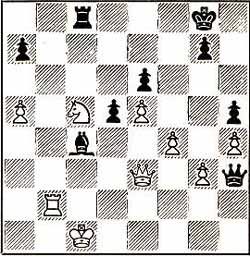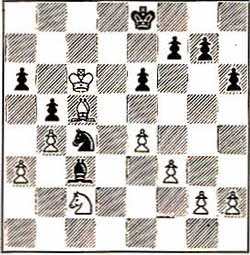|
R A D I O M A T C H R E V I E W E D
|
||
6. MY GAMES WITH BONDAREVSKY by Herman Steiner CHESS REVIEW JANUARY 1946 |
Threatens…P-R4.
40 R-R5 QR-N1
Decisive. White's King is too exposed. 43 Q-K3 Q-R6! Threatening 44 ... Q-B8ch followed by 45 ... Q-QR8
44 K-Q2
Q-N7ch Desperation. 46 . . . . Q-QR8 Not 46.,. QxP nor 46 ... PxP because of 47 R-N7 with counterchance. 47 K-B2 B-Q6ch !! The killer!
48 QxB RxNch
White resigns, for if 52 R-QR2, R-N4ch; 53 QxR, Q-Q8ch
winning the Queen.
|
|
|
Queen’s Pawn
Opening 1 N-KB3
N-KB3 Bogolyubov's move. The Idea is to exchange the Bishop by way of preparing for ... P-Q3 and ... P-K4. 4 B-Q2 Q-K2 Against Lilienthal, Pinkus played 4 ... B-K2 and got slightly the worse of it. He eventually drew. 5 P-KN3
O-O The original idea was 6 ... BxBch;
7 QNxB, P-Q3 and eventually ... P-K4. The text was first introduced by the
player of the Black pieces in 1927, and adopted by him in the important
game 7 P-QR3
BxBch In the game just quoted, Black played 9.. . P-B3, but 9 ..P-B4 is also playable. 10 Q-B2
NxN So that if 14 QxP, Black can free himself with .. P-K4, But White prevents this with his next move: 14 P-B4
N-N3 He wants to prevent Black from getting his Knight into the game, But the upshot is that White weakens too many Pawns. 15 . . . . R-Q1 Going after White's Queen Pawn, which is an attractive target. 16 P-QR4 B-Q2 Not 16 ... Q-Q2?; 17 P-R5, QxPch; 18 QxQ, RxQ; 19 N-B3! winning a piece. 17 P-R5
N-B1 18 NxP was a promising alternative.
18 . . . . B-K1
|
Gaining a valuable tempo for making room for the following Knight maneuver, which will bring further pressure against White's Pawns.
20 N-N3 N-K2 Turning his attention to the second target: the weak Queen's Knight Pawn.
25 PxP
RxP
31 K-K3 . . . .
There were better chances with 31 N-R4, R-B3; 32 R-B5,
B-B5; 33 P-N5, RxR; 34 PxR, Q-N2; 35 N-N6, R-KB1; 36 KtxB, PxKt; 37 R-Ql
with a complicated game where anything might happen.
31 . . . .
B-B5
Here White realizes that 33 R(3)-R3 is too slow because of
the continuation 33 ... R-N4; 34 Q-B7, R-B1; 35 QxP, RxP with the threat
of... R-N7 followed by ... R-K7ch and ... P-B4. The counterattack begins! 34 P-R4 . . . . Guarding against the threat of 34 ... Q-R4, attacking the King's Rook Pawn and menacing .. Q-B6ch as well.
34 . . . . Q-R4
Forcing the White King to Queen-side. |
|
|
||
|
H.Steiner
I. Bondarevsky An old•fashioned line, revived by Tartakover and subsequently played a great deal in Soviet tournaments. 8 PxP . . . . Better is 8 R-B1, playing for pressure on the Queen- side Pawns. 8. . . .
NxP 9 B-N3 . . . . Getting out of the books. Modern Chess Openings recommends 9 BxB, QxB (if 9. . . . NxB; 10 B-K2, B-N2; 11 O-O, N-Q2; 12 Q-R4, P-QR3; 13 KR-Ql, N-Q4; 14 QR-Bl with the better game (Flohr-Capablanca. Nottingham. 1936): 10 NxN PxN; 11 R-QB1, B-K3: 12 Q-R4, P-QB4; 13 Q-R3, R-B1; 14 B-K2, N-Q2: 15 O-O, P-QR3 (Eliskases-Spielmann, Match , 1936) with equality. 9. . . . P-QB4 Freeing his position with the idea of eventually controlling the open QB file. 10 NxN . . . . Black was on the point of playing 10. . . . NxN, leaving White with a Queen’s Bishop Pawn which might readily become a weakness in the endgame. 10. . . .
QxN Practically forced, as Black is threatening to obtain the advantage by 11 …PxP followed by 12 ... B-N5ch. 11 . . . .
R-Q1 Hoping to develop his King's Bishop with gain of time (13 B-QB4). 12. . . . B-R3 If 12. . . . PxP; 13 QxP,
Q-R4ch; 14 Q-B3 and the control or the open Queen Bishop file remains with
White. 13 BxB
NxB Threatening to create a target in White's camp with 17. . . . P-N5. 7 PxP . . . . Parrying White's tbreat by beginning a maneuver which will lead to wholesale exchanges of tbe major pieces. |
And not 20 R-B1 because of 20, .. NxB; 21 RxQ, NxQch; 22 K-Bl, N-B6; 23 RxB, P-R3; 24 R-R7, R-Q8ch; 25 N-K1, R-Q3!; 26 R-B7, N-N8; 27 N-B2, R-Q6 and the Queen's Rook Pawn cannot be saved saved. 20. . . . R-QB1 Best! If 20 ... NxB, White obtains control or the Queen's Bishop file. The text move seemingly gives up a Pawn, but Black will gain it back with positional advantage. 21 RxRch QxR
22 Q-B2! . . . .
The crucial point of the game: White gives up a Pawn to
secure compensation in his greater mobility, which will eventually enable
him to regain the Pawn.
22. . . . QxQ Threatening 28 P-QR4. 27 . . . . BxP Not 27 ... NxRP; 28 NxN, BxN; 29 K-B3, B-B8, 30 B-B2 and Black must give up the Queen's Rook Pawn to free his Bishop because of the White threat of 31 K-B2, B-R6; 32 B-Kl followed by 33 B-Q2 and 34 K-N3.
28 K-Q4 B-B8 Best, as he cannot allow the capture of the Queen’s Knight Pawn.
30 B-B2 B-Q7
(note: the position above is the position given in the actual annotation. However, it's contains a printing error - there should be no pawn on a3) |
34 K-N7, P-QR4; 35 PxP, NxPch; 36 K-R6 leads to an easy draw, but White was looking for complications. 34 . . . .
B-K4ch Black refuses to bite. After 35 ... BxP? Whlte would have winning chances with his Queen’s Knight Pawn. 36 PxP
NxPch Black was threatening 39 … N-K7. 39. . . .
N-K7 Black was threatening ... B--Q5 followed by ... B-N8. 43. . . .
B-Q5 The only move- threatening 46 BxB. 45 . . . .
BxB
58 N-K3 . . . . And not 58 K-K4 ?,N-N6ch followed by 59 ... N-B4 winning a Pawn, Black's only remaining winning hope (and a microscopic one at that) is that he can exchange Knights in such a way that he gains the opposition in the resulting King and Pawn ending. 58. . . .
N-N6 |
<Sommario>





